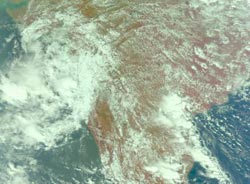NASA watching Jal's remnants in the Arabian Sea for possible rebirth

NASA\'s Aqua satellite captured this visible image of Cyclone Jal\'s remnants off the coast of Mumbai, India, on Nov. 9. It appears that there is circulation occurring in this image. Credit: NASA JPL, Ed Olsen<br>
The Atmospheric Infrared Sounder (AIRS) instrument that flies onboard Aqua captured infrared and visible images of Jal's remnants on Nov. 9 at 1:30 p.m. local time/India.
Today's AIRS imagery hints that circulation is still occurring in Jal's remnants. The circulation was particularly apparent in the AIRS visible image. The AIRS infrared satellite image showed that the strongest convection and thunderstorms are now occurring to the west of the center of circulation and over the open waters of the Arabian Sea.
At 900 GMT (4 a.m. EST) on Nov. 9, the remnants of Tropical Cyclone Jal was over the waters of the eastern Arabian Sea. The Arabian Sea is located in the northwestern part of the Indian Ocean and covers a total area of about 1,491,000 square miles.
Relative to land and the nearest city in India, Jal's remnant low was about 70 miles east-southeast of Mumbai near 17.4 North and 71.9 East. Mumbai is the capital of the Indian state of Maharashtra and is located on India's west coast. It is the most populous city in India with 14 million residents.
The forecasters at the Joint Typhoon Warning Center are monitoring Jal's remnants for possible regeneration later today.
Media Contact
All latest news from the category: Earth Sciences
Earth Sciences (also referred to as Geosciences), which deals with basic issues surrounding our planet, plays a vital role in the area of energy and raw materials supply.
Earth Sciences comprises subjects such as geology, geography, geological informatics, paleontology, mineralogy, petrography, crystallography, geophysics, geodesy, glaciology, cartography, photogrammetry, meteorology and seismology, early-warning systems, earthquake research and polar research.
Newest articles

Making diamonds at ambient pressure
Scientists develop novel liquid metal alloy system to synthesize diamond under moderate conditions. Did you know that 99% of synthetic diamonds are currently produced using high-pressure and high-temperature (HPHT) methods?[2]…

Eruption of mega-magnetic star lights up nearby galaxy
Thanks to ESA satellites, an international team including UNIGE researchers has detected a giant eruption coming from a magnetar, an extremely magnetic neutron star. While ESA’s satellite INTEGRAL was observing…

Solving the riddle of the sphingolipids in coronary artery disease
Weill Cornell Medicine investigators have uncovered a way to unleash in blood vessels the protective effects of a type of fat-related molecule known as a sphingolipid, suggesting a promising new…





















